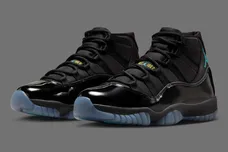"Genius." It's a term that gets thrown around in think-pieces across the internet every time one of these two guys drops new music. For Kendrick, the cachet was earned from the beginning after his major-label debut, good kid, m.A.A.d city. With tracks like "The Art of Peer Pressure," and "Sing About Me, I'm Dying Of Thirst," Kendrick displayed an indisputable knack for storytelling, combined with a distinct ability to carry overarching narratives throughout an album. Cannodading beats such as that on "m.A.A.d. city" juxtaposed with the drowsy, intoxicating production of "Swimming Pools" showed K-Dot knew when to turn it up and when to take a nuanced approach.
J. Cole attained the distinction in a slower fashion. Over the course of several solid mixtapes, Cole gained hype as one of the most promising young talents in the game, a reputation he would cement in the mainstream with his debut, Cole World: The Sideline Story. Cole proved he knew introspection with songs like "Lost Ones," but could also drop hits such as "Work Out," or "Lights Please." His love for Jazz shines through on production throughout the album that feels anachronistic of the '90s. Slow it down, add in some piano, and Cole has a baby-making-beat like "In The Morning" or "Lights Please" ready to go.
By Born Sinner and To Pimp A Butterfly, Cole and Kendrick found themselves in similar predicaments: Both artists had proved they could make a hit, but could they, not only do it again, but fight off a sophomore slump and improve their game?
Taylor Hill/Getty Images
LYRICISM
"It's way darker this time," Cole warns to start Born Sinner's harder-hitting intro "Villuminati." It's one of the conceptually tighter tracks on the album. Cole struggles between staying true to himself and being "real like Pac," or flaunting his newfound fame and bragging "like Hov."
Sometimes I brag like Hov, sometimes I'm real like Pac
Sometimes I focus on the flow to show the skills I got
Sometimes I focus on the dough, look at these bills I got
Throughout the album, Cole loosely follows the troubles of fame and fakeness of Hollywood, but at times tangentially tackles other topics that distract from an overarching purpose. "Power Trip," for instance, is a smarter, more focused update to Cole's aforementioned "Lights Please" and "In The Morning." Cole presents the negatives of desire, playing a version of himself so infatuated with his crush he turns to murder (at least in the music video). He uses alcohol to battle his obsession and despite his rising fame, he can't get over this girl. It's an easy highlight from the album-- the only issue being that it fails to contribute on a grander scale in any meaningful way.
The highest point on the album comes 15 tracks in with "Let Nas Down." The lyrics detail the story of Nas, Cole's idol, hearing his track "Work Out" and being disappointed in the radio-friendly style. Thematically, this is the most moving presentation of Cole's struggle with fame. He explains the pressures of needing a radio-friendly single for labels to have faith in an artists' commercial value and how the pressure forces artists to sell out.
By my mind that kept on sayin'
"Where's the hits?" You ain't got none
You know Jay'll never put your album out without none
And, dog, you know how come
Labels are archaic, formulaic with they outcome
Overall, Born Sinner possesses a number of solid hits from Cole, with the occasional impressive witticism, but when presented as a complete package, it's tied together like a poorly wrapped gift on Christmas.
With To Pimp A Butterfly, Kendrick Lamar takes his pen-game to unparalleled levels. Rare is the album as perfectly written as TPAB. On "Wesley's Theory," Kendrick opens the album with a sample from Boris Gardiner’s “Every N****r Is a Star," and an introduction from Josef Leimberg. Both are callbacks to the album title and present imagery of a caterpillar emerging from a cocoon to become a beautiful butterfly; a clear metaphor to Kendrick rising from Compton into fame. Immediately the vibe is cut as Kendrick raps from the present. He paints rap as a woman whom he once loved but now merely fucks to "get my nut."
From here on out, Kendrick tackles a new societal issue on each track: "Institutionalized" handles institutional racism; "u" handles depression; "Complexion (A Zulu Love)" handles beauty standards; and so on. Many tracks end with a new line from a mysterious poem. The songs all seem ostensibly unconnected, as if To Pimp A Butterfly is a series of anthologies, until a full poem is revealed at the end that ties everything together.
Lyrically, "These Walls" is a highlight from the album and an easy way to compare Kendrick's style on TPAB to Cole's on Born Sinner. For Kendrick's sensual track, as opposed to Cole's "Power Trip," Kendrick tells the story of sleeping with the girlfriend of a man who is in jail for murdering Kendrick's friend. Throughout, he continuously juxtaposes the walls of the woman's vagina to the walls of the prison.
These walls want to cry tears
These walls happier when I’m here
These walls never could hold up
Every time I come around, demolition might crush
While Kendrick ran out of steam by the end of good kid with forgettable tracks like "Real" or "Compton," he proved he doesn't plan on quitting early this time around by finishing strong with some of his best tracks to date in "The Blacker The Berry" and "i." "Mortal Man" concludes the album by revealing a conversation between Tupac and Kendrick using audio clips from an interview with Tupac prior to his death.
PRODUCTION
Production is Cole's strongest asset on Born Sinner. It consistently stays true to his "darker" promise throughout. Cole produced the vast majority of the project himself, an impressive feat that helped give Born Sinner much-needed congruency. Each song is hard-hitting, beautiful, or both, with a number of beats including a spiritual feel that retains the religious tone of the artwork. Even the first sound on "Villuminati" stems from a choir. "Trouble" is the best example of this. It's the darkest song on the album, but the lyrics are contrasted, in addition to the trap drums, with a chorus sung by a choir.
Cole implements sampling in a number of successful ways throughout Born Sinner such as on the track "LAnd of the Snakes," which incorporates the classic Outkast song "Da Art of Storytellin' (Pt. 1)." The sample subtextually compares Cole's track to Outkast's, as both speakers reminisce about girls from their past.
To Pimp A Butterfly forfeits any popular rap tropes from the time, instead favoring an amalgamation of Jazz, Funk, Soul, subtle 90's boom-bap, and more. The production on every track is remarkably catchy and consistently matches the overall tone of the song and album as a whole. Kendrick tapped a myriad of talented musicians to help him in this regard: Flying Lotus, George Clinton, Sounwave, Pharrell Williams, Thundercat, Dr. Dre, Boi 1da, and more all assisted in producing this masterpiece.
"The Blacker The Berry" is the most boisterous track on TPAB. The beat aligns with the sheer anger Kendrick throws into the lyrics. He tackles self-hatred, black on black crime and more while the beat comes alive to rage as loud as Kendrick himself, before imploding into a soft, sultry jazz tune to conclude the record. Skip back five tracks and you'll find the most euphoric production on the project. "For Sale? (Interlude)" sees Kendrick rapping in the third person from the perspective of "Lucy," short for Lucifer, who represents major labels -- not to mention the devil. The beat is piano and synth-heavy and presents an eerie disposition with the lyrics.
IMPACT
Both Born Sinner and To Pimp A Butterfly are important albums in the discographies of J. Cole and Kendrick Lamar. For Cole, Born Sinner showed that he could return to a more conscious and lyrical style of rap that helped him rise to fame through his mixtape era. Radio-hits like "Work Out," as he explains on "Let Nas Down," caused him to lose faith and reexamine his artistic merit. Cole was able to come back and drop an impressive album that, this time around, left Nas impressed. Nas even appeared on a remix of "Let Nas Down" titled "Made Nas Proud."
For Kendrick, he proved that the success he found with good kid m.A.A.d. city was not an anomaly. Not only did Kendrick live up to the hype, he surpassed it and dropped one of the most impressive rap albums in modern music. To Pimp A Butterly tackles a horde of complex societal issues in a crisp, thematically coherent manner that features distinguished songwriting and experimental production. Let us know which album you think is best below.







